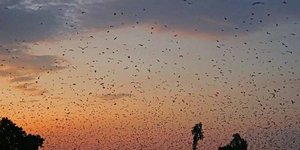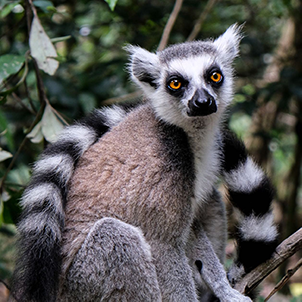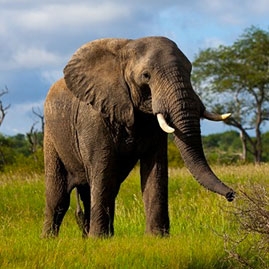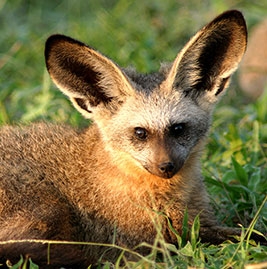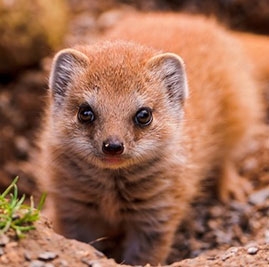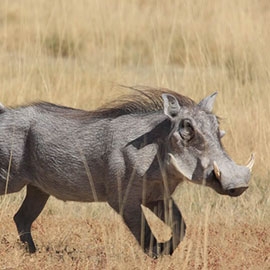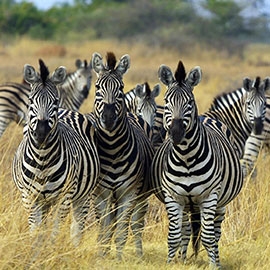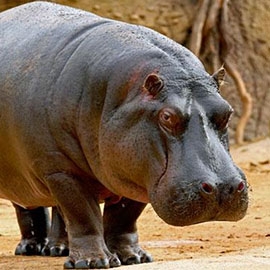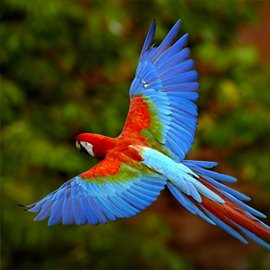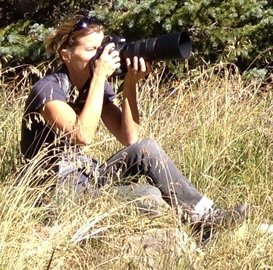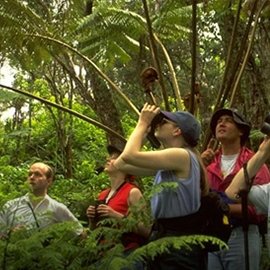Kasanka National Park
Safari suitability: 7/10
Find your tourSpecialized ecology, big game for a small park. No rhinos or lions. Park is very small but fairly easy to access.
What YAS members think
Highlights
- The only privately managed park in Zambia
- Annual fruit bat extravaganza
- Safari on foot, by bike or car
- Not crowded
- Best time to visit is October through January
About Kasanka National Park
Kasanka National Park is a small (390 km² / 150 mi²) national park in northeast Zambia approximately 500 kilometers (310 miles) from Lusaka. It is known for its annual fruit bat migration, when millions of the large “flying foxes” with their meter-wide wingspans descend upon the park. It is not only the largest bat migration in the world, it is also the largest mammal migration in the world.
Each of the estimated 10 million bats consumes more than two kilograms (4.5 pounds) of berries each day while infiltrating the park from late October until the middle of December, leaving the fertile fruit trees and bushes barren in their wake. Funded by international charitable donations to the Kasanka Trust, the park operates two lodges and three camps. Whether staying indoors or out, there are regular options for walking safaris, game drives and bicycle trips.
Kasanka wildlife
Bats notwithstanding, Kasanka’s other attraction is its Fibwe Hide, where the notoriously shy sitatunga antelope can be spotted, typically at sunrise and sunset. Among the wildlife at Kasanka are black lechwe, buffalo, civets, crocodiles, elephants, hippos, leopards, monkeys, puku and reedbuck. Over 400 species of birds are present in Kasanka. Birdwatching and fishing are very popular in this intimate national park.
When to visit Kasanka National Park
Zambia has a rainy season from October to April. The dry season is both hot and cool, but never very cold nor extremely hot. Although the rainy season begins in October, until December it is often considered hot and dry. The rains come in after the New Year. June and July are the best months for wildlife viewing. The bat migration begins in late October and lasts until the New Year. This is also the start of Zambia’s rainy season.
Sort by:

I went on a 2 day vacation in Kasanka National park in 2016 in October for the back migration, we went to view the bats in the late afternoon around 5pm to 6pm as its the time when the bats start migrating. I saw so many bats in the air and it become very dark till the the air was cleared though some were falling to the ground. It was an amazing experience. I am looking forward to visit with my family again.
 United Kingdom
United Kingdom
I would go back, but! I visited in May 2014 as part of a Zambian holiday that included Liuwa Plain, South Lungwa and Shoebill Island. The latter part of the Kasanka Trust which oversees the Kasanka National Park. (The highlight of the parks year occurs in November with the visit of the fruit bats.) The landscape is beautiful and varied, forests, woods, rivers, savannah and marshes. The food is excellent and the staff friendly and accommodating. So far so good. But the rooms are run down, the main lodge is some distance from all centres of activity, and the main area for viewing the extremely shy sitatunga has a camp site right by it. Great if all the campers are keen on seeing sitatungas but not so good if occupants of the tents are on a booze bonding week-end away from Lusaka. The vehicles used are not the easiest to get out of when not at the main lodge. No-one has thought to take steps for disembarking and embarking away from base camp. The vehicles have an enclosed cab. This means that the guide needs to slap the top of the drivers cab to get him to stop. As you can imagine the sighting has now potentially flown or run off or been passed by. On our river trip I gave up taking photographs early on, the three photographers in the group were squeezed on to one bench, with no real room for movement, and this was compounded by the spotter sitting in the prow blocking the view through the lens. There was plenty to see. Whilst there the new management seemed to be under some sort of training programme personally I felt that there was an undercurrent between the staff. But I would go back. Why? It is beautiful. Upon request we were given the opportunity for an extra and exceptionally early safari to see if we could see the sitatunga (near the tented camp) which we did through the mist of dawn. Magical.
Its not your normal safari destination. You wont find big game here nor will you find large quantities of animals. Inside the park, however, in bangweulu wetlands, Mushitu forest during October to December you will find a spectacle to behold. A phenomenon that can be described in writing, documented in video but only when experienced in person will one appreciate and be humbled by this unforgettable unique wonders. This is one of the smallest park in Zambia, but the over 8 million fruit bats (the worlds largest mammal migration)that arrive from Congo to eat the wild musuku fruits found here make this park a top visit. Our stay was at the wasa lodge, the rooms basic, flush toilets and hot water bucket showers on demand. The lodge offered a close vantage point to view the bats. One had to access l tree hides so as to get the best view of the bats. We accessed the hide at Fibwe standing at 18 metres high in a mahogany tree. This was the perfect location. Persons with mobility issues will find it cumbersome to climb to the hide as a ladder is generally used. The climb to the hide is usually in the evening/morning so as to watch the bats come out from the trees to go and feed, and they didn't disappoint. Countless no of bats emerged and darkened the sky for a bit. We were advised the bats totaled not less than 4 million at the time. Do not forget to carry good binoculars and camera so as to capture this lifetime wonder. We did the same during sunrise to view the birds return to their habitat, it was a terrific sight more up close, a bit heart thumping but in a good way. Apart from the bats we saw antelopes roaming around but no other game. The migration was awesome, millions of bats in and out in one location. A wonder if not a conundrum indeed.
Getting to Kasanka from Lusaka
Most visitors to Zambia arrive at Lusaka International Airport. It is possible to drive to Kasanka National Park and the roads are primarily tarmacked the entire way. The drive, without traffic, is around seven to eight hours.
Flying to Kasanka
Charter flights are possible to Kasanka. From Lusaka, the flight is roughly 90 minutes in duration. From South Luangwa airstrip, it is just under an hour.
The following airlines travel to Kasanka National Park

Bush & Lake Aviation is a newly established charter company offering flights from its Lilongwe base to destinations in Malawi and the adjacent regions. We offer a small team of dedicated pilots, engineers, and management with many years of experience in the aviation business. We fly directly to your destination making your connections possible and saving you the unnecessary frustrations of transfers - queues and delays Bush & Lake Aviation specializes in charters for leisure travel or business. Visit website
Also flies to:



Kasanka map
Related articles
Latest photos
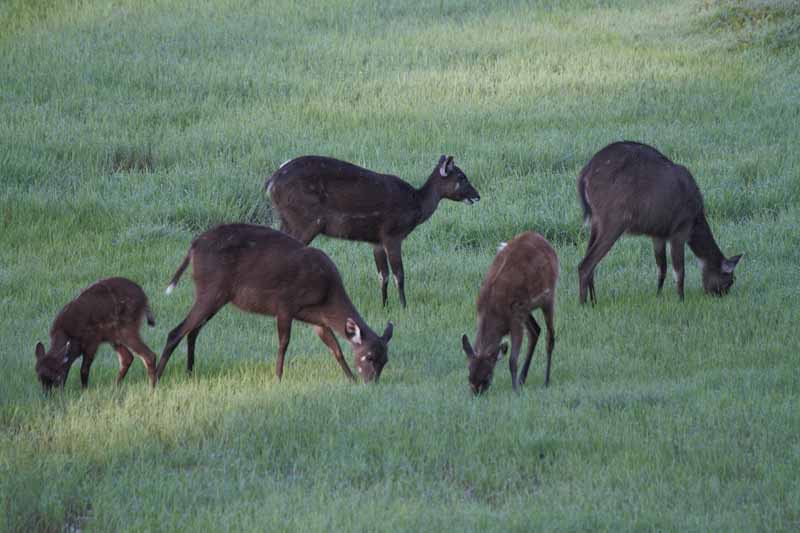


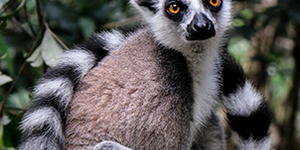
 Kenya
Kenya
